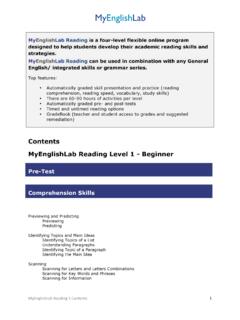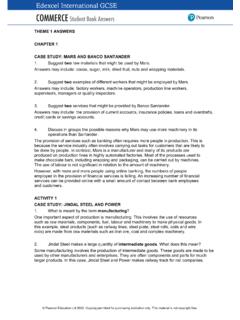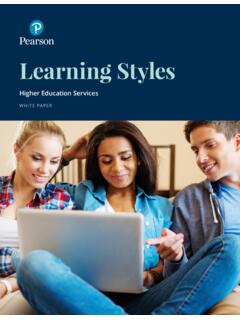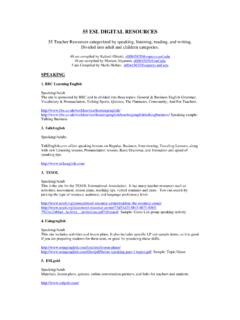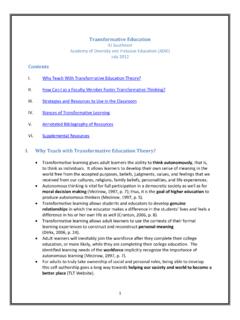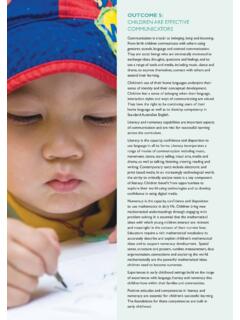Transcription of Why Is Social Responsibility Important? - Pearson
1 Social ResponsibilityExecutive Summary for EducatorsEducation researchers at Pearson are conducting a series of summaries around Pearson s Personal and Social Capabilities (PSCs), the nonacademic skills that support employability. This review focuses on teaching and assessing the skill of Social Responsibility in K 12 and college classrooms. What follows is a summary of the most significant Is Social Responsibility Important? Social Responsibility is identified as an important skill that employers expect in their hires and a crucial factor for developing ethical, just, and well-functioning societies. Research suggests that a focus on developing Social Responsibility is important for several reasons: Employers agree that Social Responsibility should be taught to college students regardless of their area of study.
2 Aspects of Social Responsibility that are particularly important to employers include intercultural skills, ethical judgment and decision-making, and civic knowledge, skills, and judgment. Participating in Social Responsibility at a young age is associated with better outcomes in adulthood, including higher life satisfaction, higher educational attainment, and more civic engagement. Building a nation s Social Responsibility has the potential to create a more involved citizenry and more caring and just Does Social Responsibility Look Like? Social Responsibility is broadly defined as taking Responsibility to behave ethically and with sensitivity toward Social , cultural , civic, and environmental issues.
3 Synthesizing across several frameworks for Social Responsibility , Pearson has defined Social Responsibility as consisting of four core dimensions of competence:1. Multicultural: Is knowledgeable about different cultural identities and sensitive toward cultural Ethical: Demonstrates knowledge and awareness of ethical standards and issues, and applies ethical reasoning and standards to make decisions in ethically ambiguous Civic: Is an informed and active citizen at the local, national, and global level, and understands and acts on issues of local, national, and global Environmental: Is knowledgeable about current issues of environmental significance, is concerned about the well-being of the planet, and engages in sustainable Can I Teach Students Social Responsibility ?
4 The dimensions of Social Responsibility incorporate both knowledge and behavior. As such, students will benefit from instruction about the knowledge base of Social Responsibility as well as guidance around what socially responsible behavior looks like. Knowledge relevant to Social Responsibility includes information about different cultural identities, ethical standards, civic issues, and sustainable practices. Teaching this knowledge in authentic contexts helps students translate that knowledge into behavioral Should I Design Social Responsibility Activities for My Classroom?Many activities that support Social Responsibility allow students hands-on experience with authentic issues, which will differ depending on which dimension of Social Responsibility is being targeted.
5 For example, programs that enhance civic competence allow students to actively engage with their communities and political processes. Relevant activities include meeting with community or political leaders, participating in Get Out the Vote efforts, analyzing and discussing real political advertisements, and completing service learning. Likewise, many interventions supporting environmental competence involve students getting out of the classroom and experiencing nature firsthand. Multicultural competence is supported by interacting with diverse groups. These authentic activities help to form the bridge between Social Responsibility knowledge and Responsibility is also supported by active-learning strategies.
6 For example, two meta-analyses found that engaging in debates was a common feature of programs that supported ethical competence. Other active-learning strategies that support Social Responsibility include: cooperative or collaborative learning; case-based instruction; problem-based learning; Should I Evaluate Students Social Responsibility ?Many measures of Social Responsibility include self-report and informant-report questionnaires that ask individuals to report on their own or others characteristics and behavior. Informant-report questionnaires in particular allow instructors to systematically report on their observations of student behavior. Scenario or dilemma-based tasks can also address some of the limitations of self-report and informant-report measures of Social Responsibility .
7 These tasks present students with a hypothetical scenario followed by questions about possible responses to that scenario. Students can be asked to indicate the best response, evaluate the response of an actor in the scenario, or explain their reasoning behind their selection of a response. These measures can allow instructors insight into how students might behave in situations outside of those observed in the are another useful tool for assessing Social Responsibility , particularly when students are actively practicing Social Responsibility . The AAC&U VALUE rubrics may be a useful resource for instructors as they align to each of our dimensions of competence (specifically Civic Engagement Local and Global, Intercultural Knowledge and Competence, Ethical Reasoning, and Global Learning ).
8 Descriptors in these rubrics are broad enough that this type of evaluation could be used for a wide range of tasks. Rubrics also support self-assessment, as they offer an easy way for students to identify next steps for the development of their Social Responsibility . For example, if a student rates themselves as falling in one range for a particular skill, they can look to the descriptors in the next highest level to identify specific behaviors they can engage in to develop and demonstrate stronger levels of the main conclusions and implications of the research for classroom practice are as follows:ConclusionRecommendationSocial Responsibility is important for academic and occupational success and can also support increased Social welfare by helping to build ethical and well-functioning should explicitly teach Social Responsibility at all levels of Responsibility includes several key dimensions of competence.
9 Multicultural, ethical, civic, and should address each of these specific dimensions of competence in their indicates that multicultural competence is supported by multicultural coursework, diversity workshops and trainings, and peer-led interventions, with interactions with diverse groups and learning about diversity being key features of effective should consider implementing multicultural coursework, particularly those that incorporate both learning about diversity and having positive interactions with diverse different school-based character education interventions for primary- and secondary-school students supported ethical competence. Features of effective programs included: role-playing and skills practice, ethical decision-making strategies, and storytelling and literature-based activities.
10 There is also support for the effectiveness of whole-school programs such as the Child Development Project and Smart Character and secondary-school educators should integrate character education programs that include features like role-play and skills practice, ethical decision-making strategies, and storytelling and literature-based activities. Administrators can also consider whole-school programs with research support such as the Child Development Project and Smart Character college students, ethical competence training appears most effective for supporting field-specific ethical behavior and decision-making as opposed to more general ethical reasoning. In particular, active participation, case-based instruction, and opportunities for practice support effective ethical instructors should focus on teaching students about how to behave ethically in particular contexts relevant to their future careers as well as ethical decision-making.




